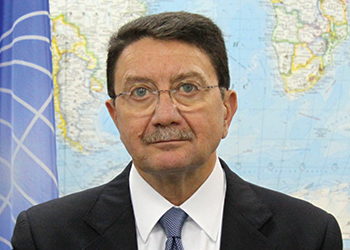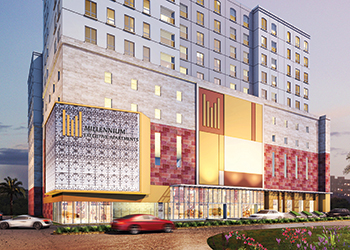
More than one million hotel rooms are under construction around the world in what promises to be a robust period of growth for the hospitality industry.
From the Americas to the Middle East and Asia Pacific, over 8,154 hotels – and a staggering 1,372,102 rooms – are under contract, according to STR’s Global Construction Pipeline, released this February. The US and Asia Pacific account for nearly one million rooms between them, with the Middle East and Africa region set to see 149,799 rooms in 640 new hotels. These do not account for conversions.Developers and operators are investing in hospitality on the back of higher demand, lower oil prices, rising millennial travel and greater numbers of outbound travellers from emerging markets. Travel is more popular than ever – with international arrivals climbing from 1.13 billion in 2014 to 1.6 billion in 2020, World Travel Organisation (UNWTO) data shows. 'People are on the move. While the IT revolution makes our dreams and our hopes the same, the travel and tourism revolution makes us explore our differences and the beauty of our diversity,' Taleb Rifai, Secretary General of the UNWTO said at ITB Berlin this year. 'Our sector has remained strong in spite of many challenges.'And with hotel sales rising around the world, driven by strong performances in the US and Asia-Pacific, that industry strength is what hospitality majors are relying on in the years ahead. Brands including Marriott, Hilton, IHG and Starwood reported strong earnings in 2014, which alongside substantial net growth, is a clear indication of an industry on the rebound.So where can we expect the most new openings and conversions? Where are the brands going? Read on for more.HiltonFollowing its successful initial public offering last year, Hilton says it has taken the lead in rooms under construction. The group added over 36,000 rooms to its portfolio in 2014, taking its strength to 715,000 rooms at 4,300 properties across 12 brands. In 2014, it entered Myanmar, Kazakhstan and Ukraine, taking its footprint to 94 countries and territories. Its pipeline now makes up 18.7 per cent of the industry’s total, with more than 1,350 hotels and nearly 230,000 rooms. About 10 per cent of these are in the Middle East and Africa. Hilton will welcome properties in Brussels, Munich, San Francisco and Rio de Janeiro this year, while Conrad will open in Manila this year and Makkah and Guangzhou next year.The company is also rolling out two new brands, Curio – A Collection by Hilton, and Canopy by Hilton.
FHRIThe Middle East remains a strategic area of expansion for FHRI, which wants to have 30 hotels in the region over the next couple of years, its Americas president Kevin Frid said in New York recently. After inaugurating a Raffles in Istanbul last year, the brand will open in Jeddah, while Swissôtel will welcome properties in Bodrum, Jeddah and Dubai. Fairmont, meanwhile, will launch hotels in Riyadh, Istanbul, Amman, Jeddah, Fujairah and Ajman, besides Lagos and Moscow. In total there are more than 40 hotels in the pipeline, with China the other prominent market on its radar.
IHGWith nine brands in its portfolio, IHG currently operates 710,295 rooms at over 4,800 hotels in nearly 100 countries. As of December, another 1,221 hotels with 193,772 rooms were in development. The Holiday Inn and Holiday Inn Express account for the majority at 773 properties, while geographically, most of this portfolio – 776 hotels – is in the Americas. More than 140 new hotels will be added to its Middle Eastern inventory. After opening the first two Even Hotels last year, 2015 saw the first Hualuxe hotels in China; another 34 are planned. Group openings this year include Ras Al Khaimah, Bali, London, Helsinki, Madrid and New York.
 |
Millennium Executive Apartments opened in Muscat and a flurry of other developments are to follow this year, including Studio M, a new brand, and the 677-key Bab Al Qasr in Abu Dhabi |
AccorPerhaps the most bullish of the top five groups is the French marque, which opened 208 new hotels in 2014 with 29,556 rooms, taking its network to 3,717 hotels and 484,296 rooms. To cement its leadership in Europe while expanding in emerging markets, Accor aims to maintain this pace in 2015, simultaneously reinforcing an asset-light strategy. New openings in January alone were the Ibis Manama Seef in Bahrain and the Pullman Dubai Grand Jumeirah Lake, as well as 14 others, including seven in Paris, and one each in India and China. By 2020, the group hopes to have 30,000 rooms in the Middle East, as compared to 16,000 in 2014, CEO Sebastian Bazin said in November. Accor has nearly 70 existing properties in the region and 34 more under development.
KempinskiAfter exiting several management agreements, including for properties in Switzerland and Equatorial Guinea, the German brand is continuing its expansion plans with 35 hotels in the pipeline as of March. In 2014, it opened six hotels, signed another 12 (including Myanmar), and extended its management contracts for eight hotels, among them Emirates Palace. The brand kicked off 2015 with the opening of the Marsa Malaz Kempinski at The Pearl Doha, followed by the new Sunrise Kempinski in Beijing. In time for the summer holidays is a Kempinski in the Bavarian Alps, while inaugurations in China, Egypt, Saudi Arabia and Lebanon will follow later this year.
SheratonBy 2016, Starwood’s flagship brand hopes to be operating 500 hotels, following the opening this year of 20 new properties, including debuts in Sri Lanka and Romania. One-third of its new hotels will be in Asia-Pacific, driven by accelerating demand across China. Other new openings include India, Italy, Senegal, Russia and the US, besides two new properties in the Middle East (including a resort in Sharjah). Sheraton expects to have open 50 more hotels and enter another 14 countries by the end of 2018. Among these are five properties each in the Middle East and Africa, according to Global Brand Leader Hoyt Harper.Starwood, Sheraton’s parent company, added about 8,000 net rooms in 2014, taking its total to over 350,000 rooms over 1,222 hotels. At December 31, Starwood had about 480 hotels in the active pipeline, or 108,000 rooms.
MarriottBy the end of 2015, Marriott expects to have more than one million rooms operational or in the pipeline, generating over $50 billion in real estate investment and adding more than 150,000 jobs. In 2014, the company added 46,000 new rooms to its existing 700,000, signed agreements for over 650 hotels and increased its pipeline to nearly 240,000 rooms. With a footprint of over 100 countries, key growth markets are the Middle East and Africa, North America and Asia-Pacific. Other exciting news is the launch of Moxy, a budget brand for millennial travellers, while openings in 2015 include JW Marriott properties in Bodrum, Vancouver and Cabo San Lucas, as well as Ritz-Carlton hotels in Macau and New York.
HyattOver the past two calendar years, Hyatt opened 94 hotels, representing an 18 per cent net increase in system size, president and CEO Mark Hoplamazian said. As of December 31, the company had executed management or franchise contracts for approximately 250 hotels or about 55,000 rooms across all brands. For 2015, the aim is to open approximately 50 hotels across its brands, as well as roll out Hyatt Centric, a new brand with 15 hotels, including properties in New York, Paris, Atlanta, Miami and Chicago.
By Clark Kelly
